Translate this page into:
Comparison of Eye Scan Patterns in Expert and Novice Pilots during Runway Approach and Landing
Abstract
Introduction:
Landing is one of the most critical phases of flying. Studies have shown that maximum percentage (46%) of fatal accidents occur during the landing phase of flight. Expert pilots are expected to perform better than novice pilots during this phase of flight. This study aims at analyzing the eye scan patterns of expert pilots in comparison with novices during a visual landing approach.
Material & methods:
A total of 10 experienced and 10 novice pilots were included in the study. The study was conducted on the Airfox DISO® SD simulator. All subjects flew a simulated visual approach from 15 nm and carried out a landing with a head mounted ASL® Mobile Eye Tracker recording their eye scan patterns. The dwell duration and fixations on various areas of interest over main instrument panel and on the runway were recorded and analysis was done using appropriate statistical methods.
Results & Discussion:
Experts had shorter dwell duration and more total number of fixations. They also had more runway fixation, almost no fixation over Gyro compass and over VSI (Vertical Speed Indicator). Novice pilots had lesser total fixations, lesser fixations on runway and increased fixations on all other AOI (Area of Interest). They also had increased dwell times in comparison with the expert pilots. This study also revealed that expert pilots had better defined eye scan patterns. The results of this study can be used for performance optimization in the cockpit leading to better training outcomes.
Keywords
Expert pilots
Novice pilots
Airfox DISO® SD simulator
ASL® mobile eye tracker
Fixations
Dwell duration
Eye scan patterns
Introduction
Flying an aircraft consists of many phases, some phases of which are critical. The critical phase of flight includes the take-off run, the take-off flight path, the final approach, the landing including the landing roll and any other phase of flight as determined by the pilot in command or commander [1].
The landing phase of flying is traditionally considered the most difficult phase and it needs more practice than other phases of the flying. During landing, the pilot has to touchdown at a specific point on the runway, while negotiating turbulence and crosswinds. So the demands on a pilot are extremely high during landing.
46% of the fatal accidents have been shown to occur during the approach and landing phases of flying [2].
Buswell was among the first investigators to measure both a viewer’s direction of gaze and the duration of each fixation in a scene. He concluded that there was an important relationship between eye movements and visual attention. Eye movements are the unconscious adjustments to the demands of attention during a visual experience [3].
Eye tracking devices can aid in capturing pilots visual scan pattern and therefore, integrating eye tracking devices into the simulator may be a useful method for promoting training and can provide in depth understanding of the mechanism of visual scan pattern and information to improve training effectiveness in aviation [4, 5].
Two important aspects of gaze control during scene perception are where fixations tends to be directed (fixation position) and fixation duration. The influence of visual and cognitive factors on fixation is widely acknowledged in the human gaze control literature and has been explicitly incorporated in computational models of reading [6].
Experts pilots are able to attend quickly to relevant indicators for required information when making decisions with a pattern of more fixations and shorter fixation duration during landing operations [7]. Therefore, it was suggested that fixations number and fixation duration focused on certain AsOI (areas of interest) might indicate where fixation is located. The distribution of fixation and fixation duration on relevant AOI can be not only an effective indicator of pilot’s expertise level, but can also be closely related to a pilot’s situational awareness [7].
This study analyses the cockpit instrument eye scan pattern of expert pilots in comparison with novices during a visual landing approach in the DISO simulator.
Material and Methods
A total of 20 male fighter pilots of the IAF volunteered for this study (n=20). The subjects were divided into two groups-
Expert group (n= 10)
Novice group (n=10)
The study was conducted in a Airfox DISO® SD simulator (AMST, GmbH, Austria). It has a comprehensive application software comprising a set of ready to use training programmes for the demonstration of actual combat and in-flight emergency scenarios for SD phenomena demonstration, as well as typical IFR (Instrument flight rules) training procedures. A six degree of freedom hydraulic motion platform with an additional gear axis module represent seven independently controllable motion axes. It has a cabin mounted on top of the motion platform, containing a functional aircraft cockpit including three panels, centre and two side panels, a centre stick, collective, pedals including brakes, and a pilot seat.
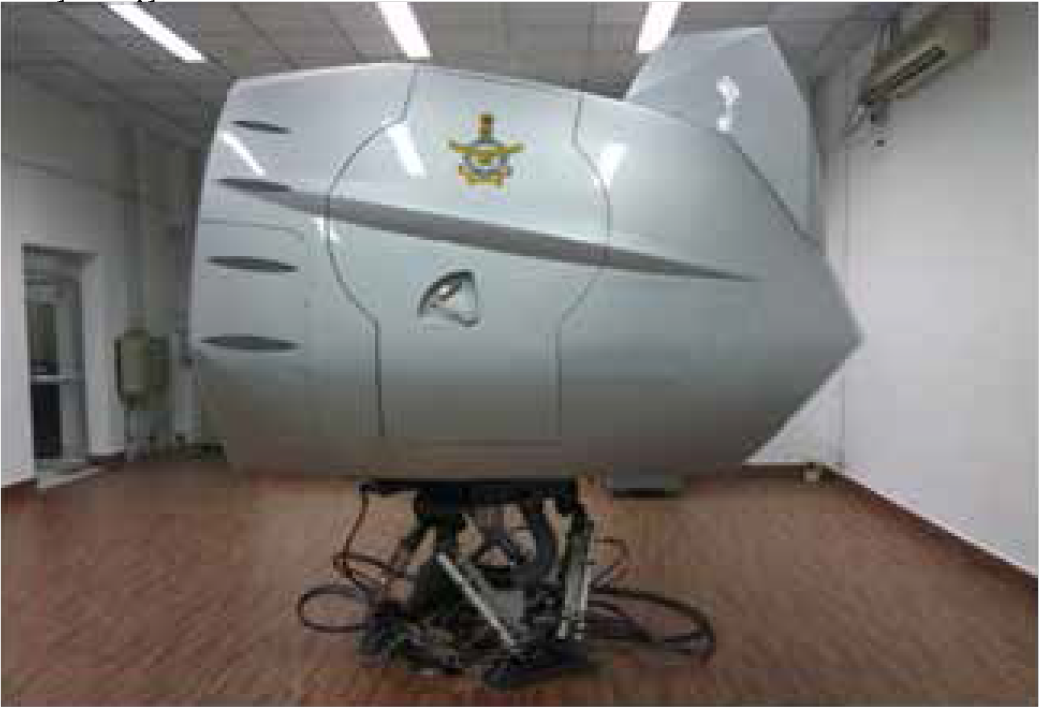
- Airfox DISO® SD simulator
Eye scan recordings were made using an ASL® mobile eye tracker (Applied Science Laboratory, Bedford, MA, USA). It can record eye movements and point of gaze information during the performance of natural tasks. The pattern of eye movements and the related data were collected by a digital video recorder and transferred to computer for further analysis.
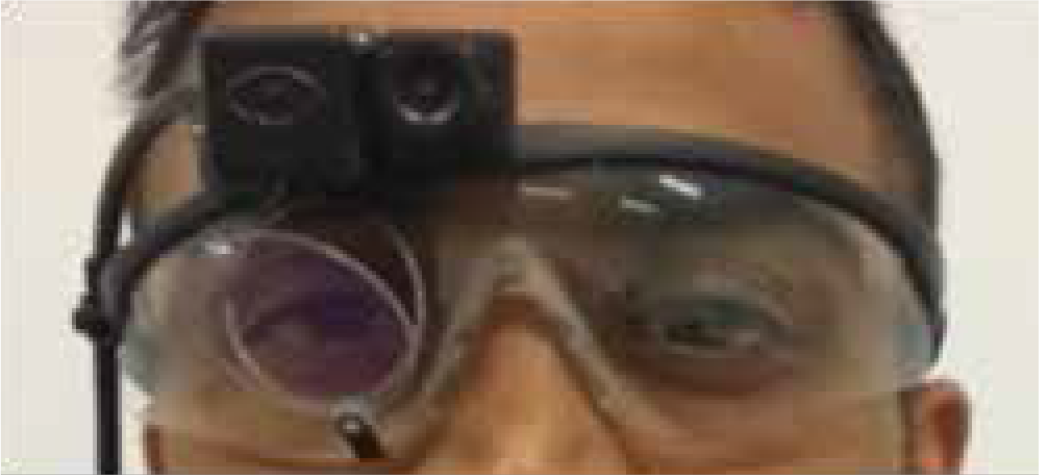
- A subject wearing the ASL® mobile eye tracker
The demographic distribution and experience of the volunteers is listed in Table 1:-
| Expert | Novice | |
|---|---|---|
| Numbers of subjects | 10 | 10 |
| Minimum age | 29 yr | 23 yr |
| Maximum age | 39 yr | 25 yr |
| Average age | 33.8 yr | 23.6 yr |
| Minimum experience | 6 yr | 1 yr |
| Maximum experience | 16 yr | 3 yr |
| Average experience | 11.6 yr | 1.6 yr |
| Average flying hours | 1659 hrs | 231 hrs |
Study Protocol. The aircrew subjects were familiarized with the control of the simulator through a pre flight for 5 minutes in VMC. Next they were instructed to fly a simulated visual approach to a runway from 15 nm and 4500 ft above MSL (mean sea level) and land the aircraft on the runway. Their eye scan patterns during this simulated visual approach were recorded.
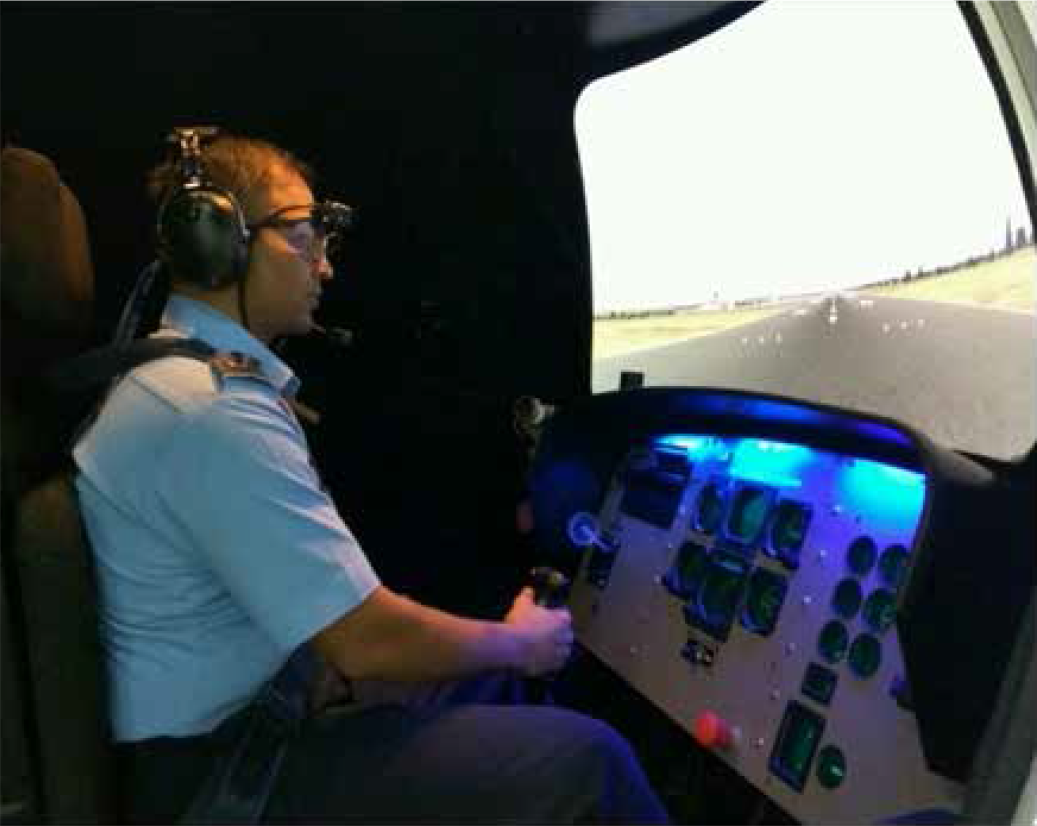
- Eye scan patterns recording in Airfox DISO® SD simulator
A total 07 AOIs were set up to observe the subjects eye scan patterns during the approach and landing task. These AOIs are listed in Table 2.
| AOI 1 | Runway |
|---|---|
| AOI 2 | Air speed indicator (ASI) |
| AOI 3 | Artificial horizon |
| AOI 4 | Altimeter |
| AOI 5 | Gyro compass |
| AOI 6 | Automatic direction finder (ADF) |
| AOI 7 | Vertical speed indicator (VSI) |
Statistical analysis
Total number of fixations, dwell duration, total time of fixation were considered primary outcome variables. The primary explanatory variable was the study group (Expert Vs Novice). All the outcome variables were compared for seven different AOIs between the two groups.
Initially all the outcome variables were checked for normal distribution using visual inspection of histograms, normality q-q plots and Shapiro Wilk test. Since the variables were non normally distributed, it was decided to compare median and IQR (Interquartile range) between the two groups. Non parametric tests like Mann-Whitney U test and Independent sample median test were used to test statistical significance. Appropriate graphical representations like bar diagram and comparative scatter plot were used.
P value < 0.05 was considered statistically significant. IBM SPSS version 22 was used for statistical analysis.
Results
| Area of interest | Group 1 Median (IQR) | Group 2 Median (IQR) | Mann Whitney U test | Independent sample median test |
|---|---|---|---|---|
| AOI 1 | 60(57.50,075.50) | 24(19.75,29.25) | <0.001 | 0.313 |
| AOI 2 | 0(0,2) | 9.50(7.75 ,13) | <0.001 | 0.010 |
| AOI 3 | 4(2 ,5.50) | 7.50(5.50 ,10) | 0.023 | 0.033 |
| AOI 4 | 3(1,3.50) | 3(2,5) | 0.190 | 0.215 |
| AOI 5 | 0 | 2(2,5.50) | <0.001 | 0.005 |
| AOI 6 | 2(1,3) | 2.50(1.75,3) | 0.497 | 0.384 |
| AOI 7 | 0 | 2(1,6.25) | <0.001 | 0.065 |
AOI 1 - The Median number of fixations in Expert Group were 60 and novice group were 24. The difference is statistically significant (p value<0.001).
AOI 2 - The Median number of fixations in Expert Group were 0 and Novice group were 9.50. The difference is statistically significant (p value<0.001).
AOI 3 - The Median number of fixations in Expert Group were 4 and Novice group were 7.50. The difference is statistically not significant (p value=0.023).
AOI 4 - The Median number of fixations in Expert Group were 3 and Novice group were 3. The difference is statistically not significant (p value=0.190).
AOI 5 - The Median number of fixations in Expert Group were 0 and Novice group were 2. The difference is statistically significant (p value<0.001).
AOI 6 - The Median number of fixations in Expert Group were 2 and Novice group were 2.50. The difference is statistically not significant (p value=0.497).
AOI 7 - The Median number of fixations in Expert Group were 0 and Novice group were 2. The difference is statistically significant (p value<0.001).
Fig 4 Shows that Expert had more fixation over AOI1, no fixation over AOI 5 and 7. Although diagram is showing zero fixation (median value) at AOI 2 for expert, but three out of 10 pilots had some fixation over AOI 2.
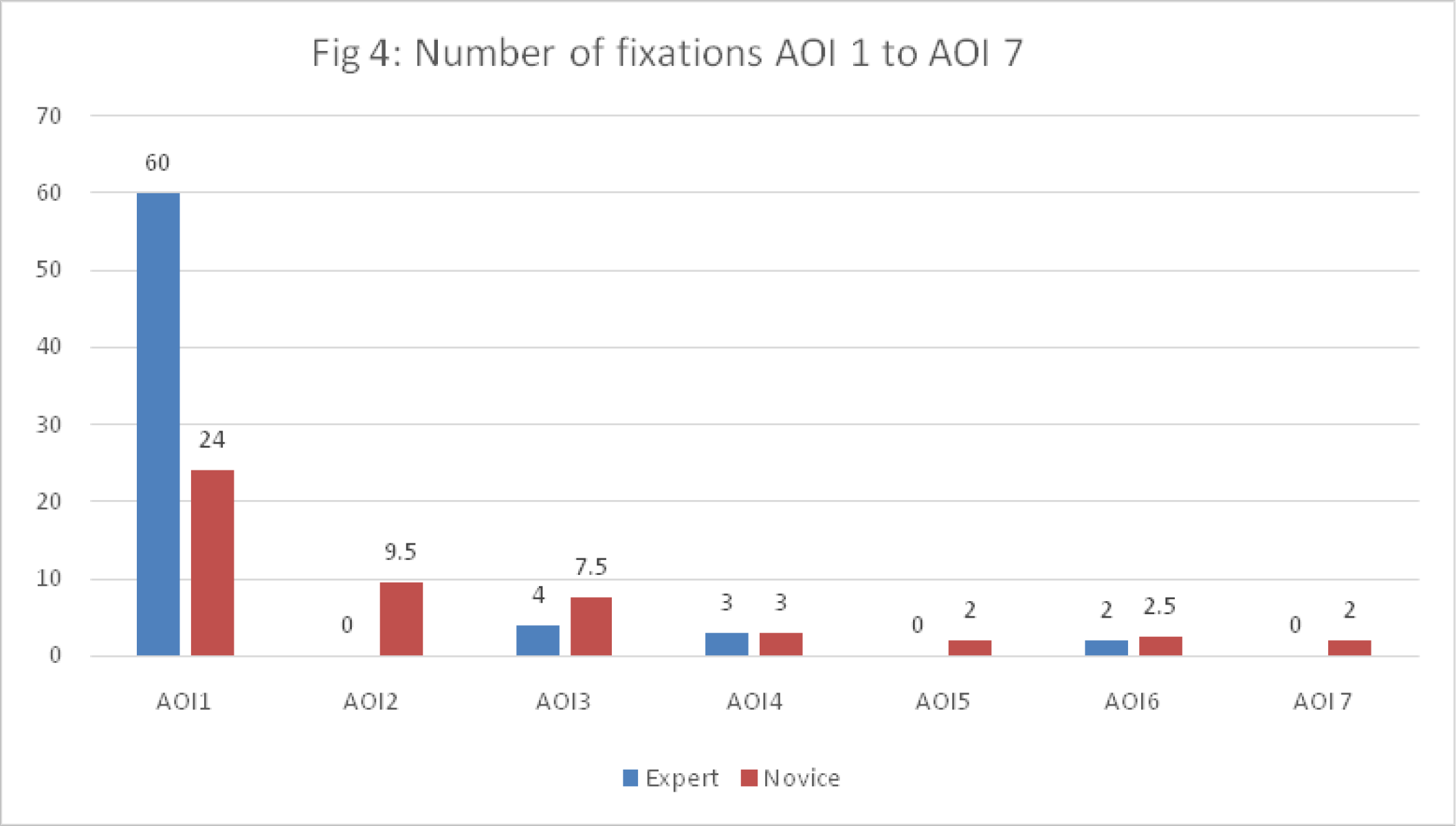
- Distribution of number of fixations at different Area of Interest (From AOI 1 to 7) between expert group (n=10) and novice group (n=10)
| Area of interest | Group 1 Median (IQR) | Group 2 Median (IQR) | Mann Whitney U test | Independent sample median test |
|---|---|---|---|---|
| AOI 1 | 0.79(0.65,2) | 2.67(2.1,3.11) | 0.019 | 0.747 |
| AOI 2 | 0(0,0.29) | 0.65(0.58,0.91) | <0.001 | <0.001 |
| AOI 3 | 0.20(0.18,0.39) | 0.74(0.29,0.89) | 0.015 | 0.004 |
| AOI 4 | 0.13(0.10,0.18) | 0.61(0.42,0.87) | <0.001 | 0.003 |
| AOI 5 | 0 | 0.33(0.27,0.450 | <0.001 | 0.010 |
| AOI 6 | 0.19(0.13,0.25) | 0.60(0.37,0.77) | <0.001 | <0.001 |
| AOI 7 | 0 | 0.31(0.28,0.37) | <0.001 | <0.001 |
AOI 1 - The Median dwell duration in Expert Group were 0.79 and novice group were 2.67. The difference is statistically not significant (p value=0.019).
AOI 2 - The Median dwell duration in Expert Group were 0 and Novice group were 0.65. The difference is statistically significant (p value<0.001).
AOI 3 - The Median dwell duration in Expert Group were 0.20 and Novice group were 0.74. The difference is statistically not significant (p value=0.015).
AOI 4 - The Median dwell duration in Expert Group were 0.13 and Novice group were 0.61. The difference is statistically significant (p value<0.001).
AOI 5 - The Median dwell duration in Expert Group were 0 and Novice group were0.33. The difference is statistically significant (p value<0.001).
AOI 6 - The Median dwell duration in Expert Group were 0.19 and Novice group were 0.60. The difference is statistically significant (p value<0.001).
AOI 7 - The Median dwell duration in Expert Group were 0 and Novice group were 0.31. The difference is statistically significant (p value<0.001).
Fig 5 Shows that Expert had lesser dwell duration than novice, no dwell over AOI 5 and 7. Although diagram is showing zero dwell duration (median value) at AOI 2 for expert, but three out of 10 pilots had some dwell over AOI 2.
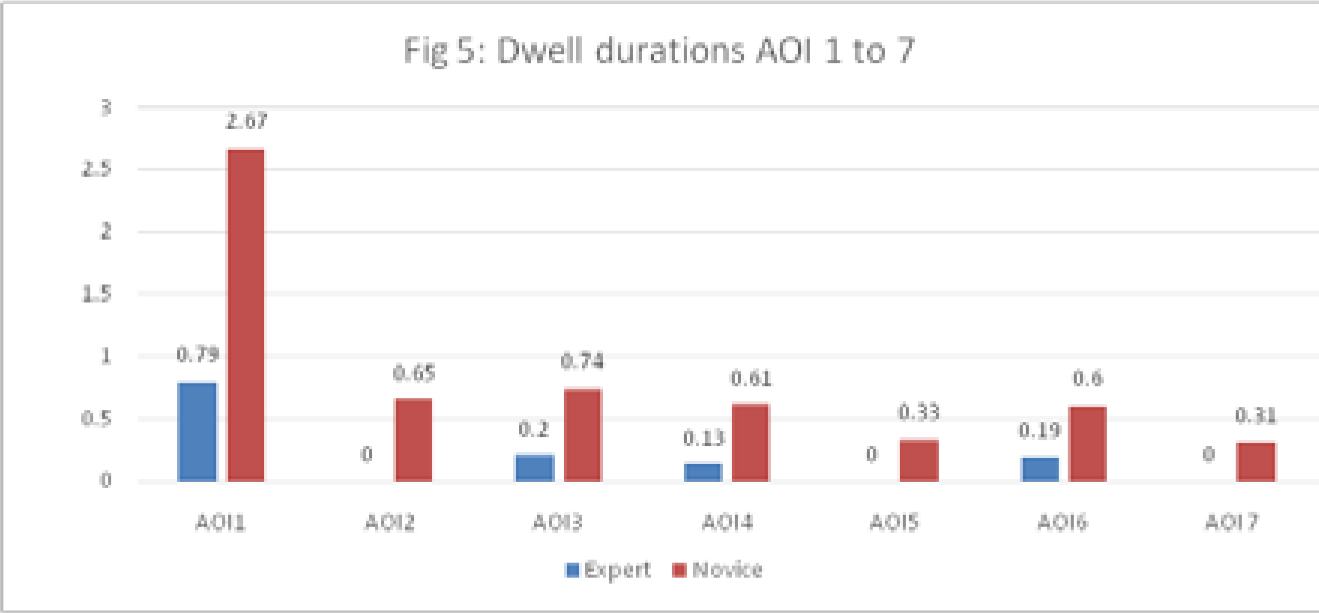
- Duration of time spent at different Area of Interest (From AOI 1 to 7) between expert group (n=10) and novice group (n=10)
| Area of interest | Group 1 Median (IQR) | Group 2 Median (IQR) | Mann Whitney U test | Independent sample median test |
|---|---|---|---|---|
| AOI 1 | 12(8,17) | 6(5,2) | 0.029 | 0.900 |
| AOI 2 | 0(0,1.7) | 3.18(2.1,4.7) | <0.001 | <0.001 |
| AOI 3 | 0.47(0.1,0.6) | 1.5(0.5,3.5) | 0.019 | 0.084 |
| AOI 4 | 0.1(0.1,0.1) | 0.4(0.3,3.4) | <0.001 | 0.032 |
| AOI 5 | 0 | 1.1(0.8,2) | <0.001 | 0.002 |
| AOI 6 | 0.1(0.9,0.2) | 0.4(0.3,0.7) | <0.001 | 0.226 |
| AOI 7 | 0 | 0.2(0.2,0.5) | <0.001 | 0.050 |
AOI 1 - The Median time of fixation in Expert Group were 12 and novice group were 6. The difference is statistically not significant (p value=0.029).
AOI 2 - The Median time of fixation in Expert Group were 0 and Novice group were 3.18. The difference is statistically significant (p value<0.001).
AOI 3 - The Median time of fixation in Expert Group were 0.47 and Novice group were 1.5. The difference is statistically not significant (p value=0.019).
AOI 4 - The Median time of fixation in Expert Group were 0.1 and Novice group were 0.4. The difference is statistically significant (p value<0.001).
AOI 5 - The Median time of fixation in Expert Group were 0 and Novice group were1.1. The difference is statistically significant (p value<0.001).
AOI 6 - The Median time of fixation in Expert Group were 0.1 and Novice group were 0.4. The difference is statistically significant (p value<0.001).
AOI 7 - The Median time of fixation in Expert Group were 0 and Novice group were 0.2. The difference is statistically significant (p value<0.001).
Fig 6 Shows that Expert had more TOF % over AOI1, zero TOF % over AOI 5 and 7. Although diagram is showing zero TOF (median value) at AOI 2 for expert, but three out of 10 pilots had some TOF over AOI 2.
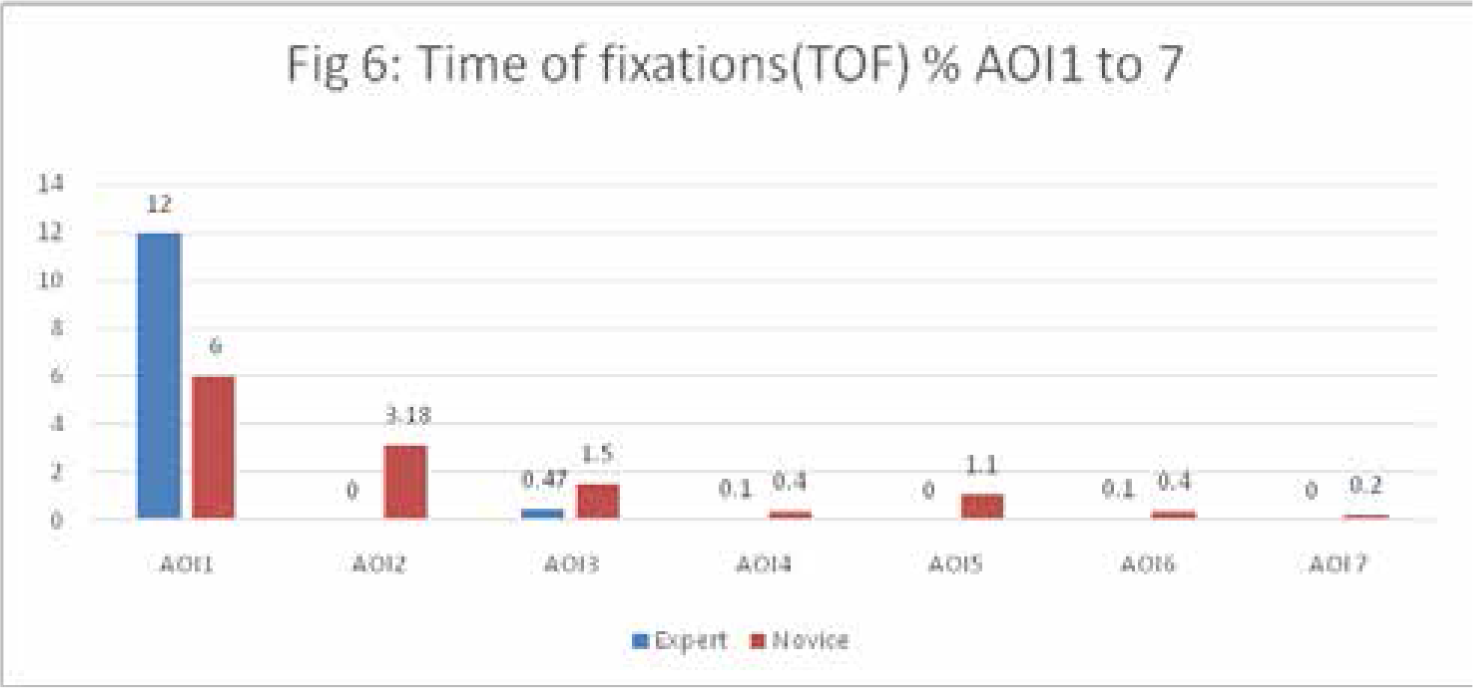
- Time of Fixation (ToF) in % at different Area of Interest (From AOI 1 to 7) between expert group (n=10) and novice group (n=10)
Fig 7 shows that Expert had more fixations and less dwell duration than novice. Fig 8 clearly shows that Expert had more fixation over runway, few fixation over ASI, no fixation over Gyro compass and VSI. Fig 9 shows that novice had fixations over all AOIs, but less fixation than expert over AOI 1 (Runway).
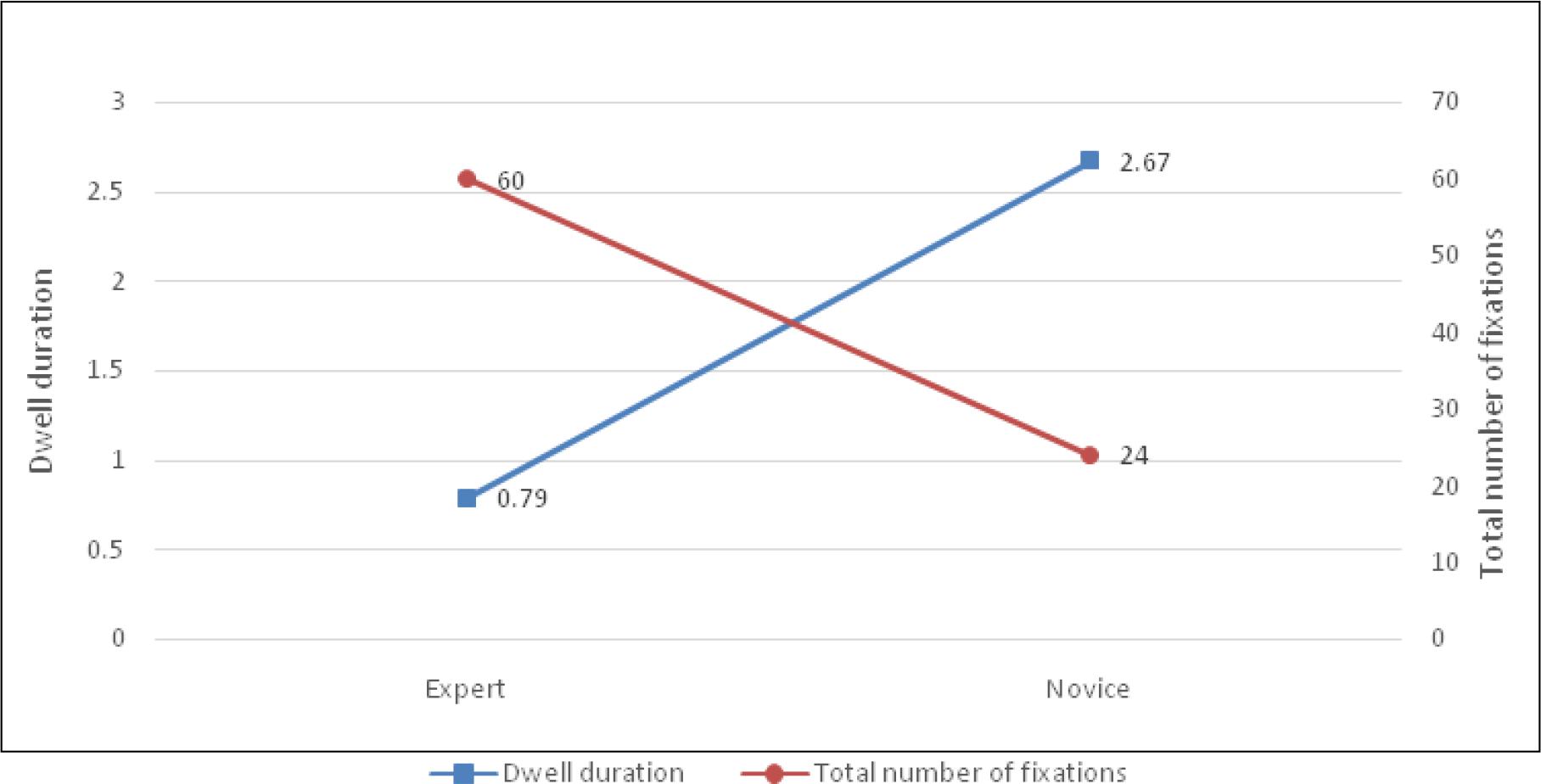
- Comparission of dwell duration and total number fixations between expert group (n=10) and novice group (n=10)
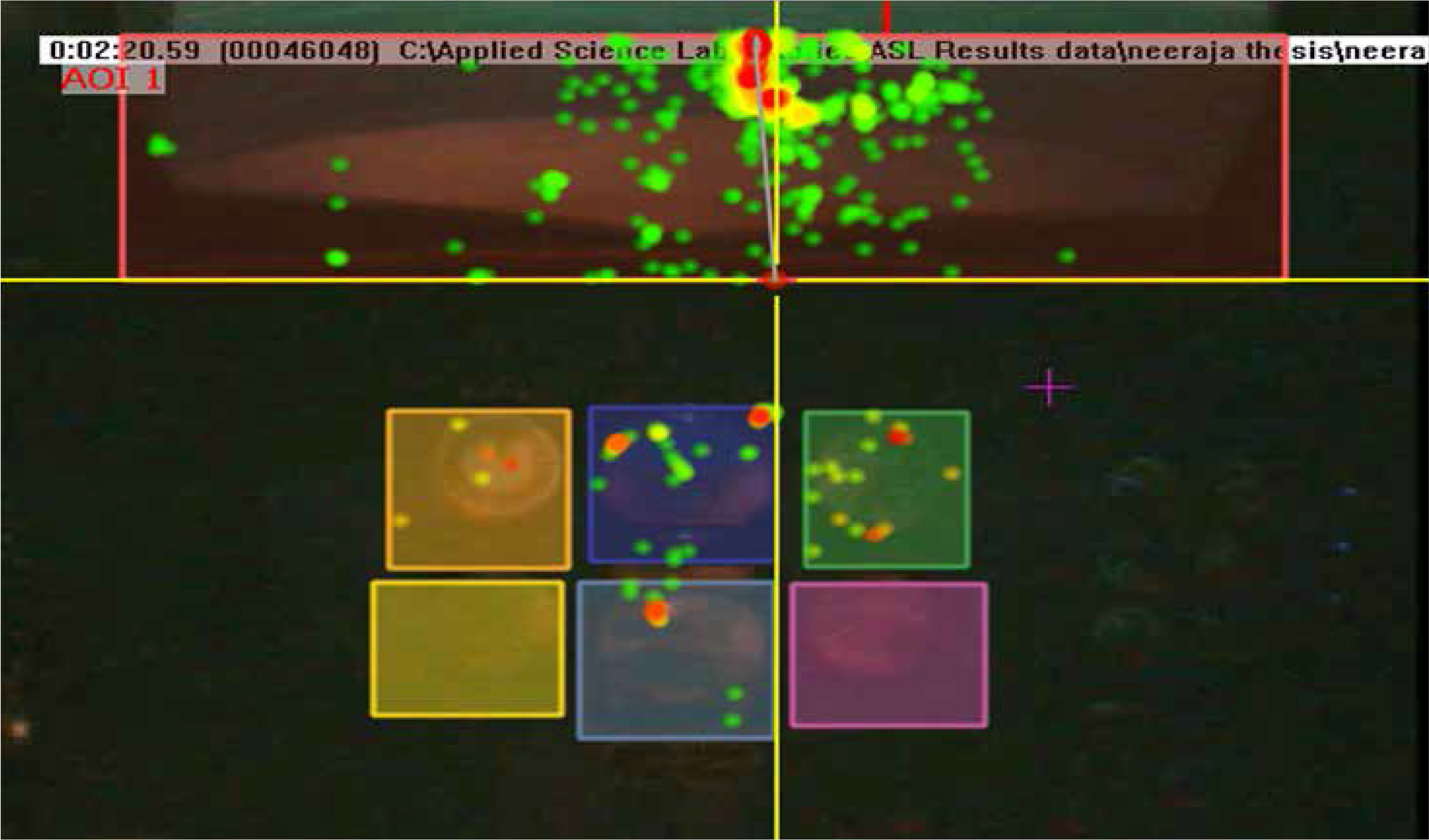
- Expert pilot heat map of fixation over AOIs
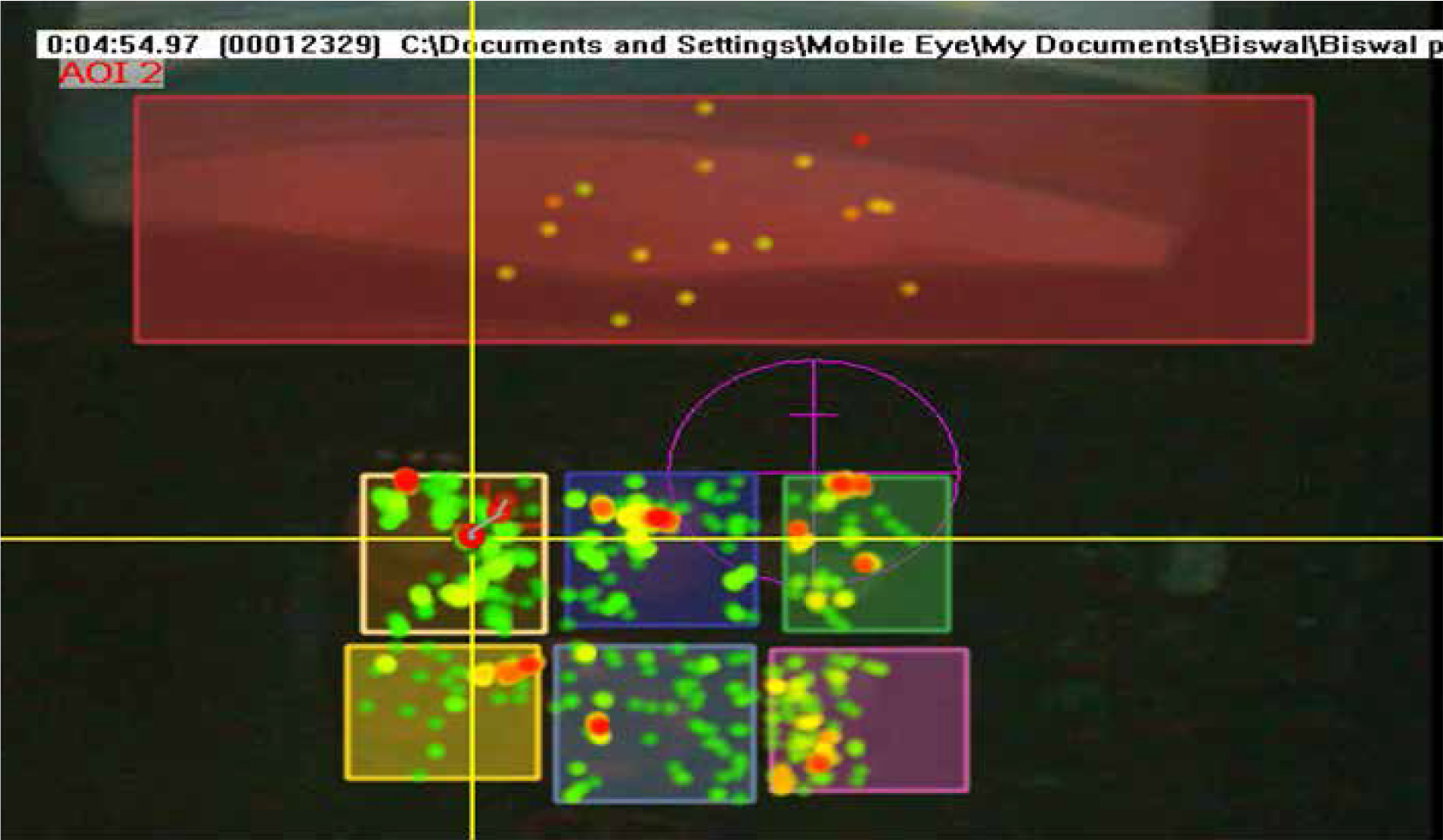
- Novice pilot heat map of fixation over AOIs
Discussion
Kasarskis and Hickox found in their study that experts had significantly shorter dwells, more total fixations, more airspeed fixations and fewer altimeter fixations than novice. They found more fixations over runway and then the ASI. This study also showed that expert pilots perform better landing than novices [4]. Bellenkes et al studied the differences of eye scanning in expert and novice pilots during IFR cruise flying and they observed that experts had shorter dwells and more fixations to most instruments than novice pilots. They also found that experts visited the ASI more frequently than novice [5]. In our study, we also found that expert had shorter dwells and more total fixations, more runway fixation than other AOI, but they almost did not fixate over AOI 5 (Gyro compass) and over AOI 7 (VSI) at all. Out of ten expert pilots only three had a glanced at AOI 2 (ASI) implying that expert group hardly viewed AOI 2 (ASI). Novice eye scan shows a discrete type of pattern, they fixated over all AOIs. In contrast, the expert eye scan exhibited a clearly defined pattern, they did not fixate over AOI 5 and 7. From the results, we can say that there is some difference in results of present study and the studies done in the past. In the previous studies the AOIs were described like runway, ASI and altimeter, however the author did not designate other AOIs (Gyro compass, Artificial horizon, ADF, VSI), which may be a cause of difference. As we all know that the correct instrument scan technique taught to pilots as laid down in the books, however their actual fixation developed only after the experience.
Limitations
In this study the number of subject was less. Being a pilot study the total number of subject was only 20. The second limitation of the study was that the data were the average of all parameters and were collected for the entire duration of the flying from 15 nautical miles till the runway touchdown. The result may be varied if the data were collected for every 5 nautical miles of the flying.
Conclusions
The findings of this study indicated that the expert pilots had better defined eye scan patterns than the novice. The results of this study can be used for the optimization of eye scan pattern of novice pilots, utilizing the scan pattern of experienced ones as a training tool for better training outcomes.
Acknowledgement
My sincere and heartfelt gratitude to Air Cmde Narinder Taneja VSM, Gp Capt M Mohan, Gp Capt MS Nataraja, Gp Capt YS Dahiya, Lt Col P Biswal for their determined guidance, support and mentorship throughout the conduct of the study.
References
- 2005. [cited 2017 Feb 23] Available from: https://www.easa.europa.eu/.../regulations/commission-regulation-eu-no-9652012
- [Google Scholar]
- Fatal accident report [Internet] 1999. [cited 2017 Feb 13] Available from: https://www.researchgate.net/publication/288408012_Analysis_of_critical_factors_during_approach_and_landing_in_accidents_and_normal_flight
- [Google Scholar]
- How people look at the pictures In: Univercity of Chicago Press XVI 1935 [internet]. 2015. [cited 2017 Feb 13]. Available from
- [CrossRef] [Google Scholar]
- Comparison of expert and novice scan behaviors during VFR flight. Paper presented at 11th International Symposium on Aviation Psychology;. Columbus, OH: Ohio State University; :5-8.
- [Google Scholar]
- Visual scanning and pilot expertise: their role of attentional flexibility and mental model development. Aviat Space Environ Med. ;68(7):569-79.
- [Google Scholar]
- Psychol Rev. 1998;105:125-57.
- [Google Scholar]
- Pilots visual scan patterns and situation awareness in light operations. Aviat Space Environ Med. 2014;75(6):708-14.
- [Google Scholar]






